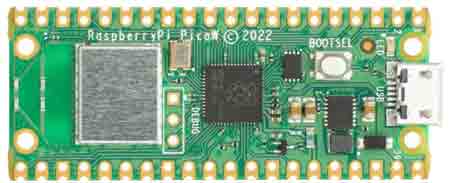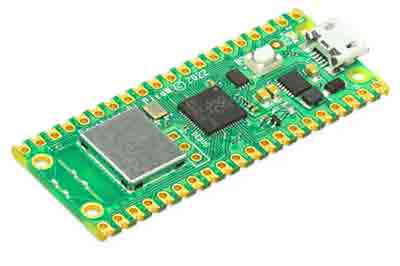Today we woke up to the news of a new model of Raspberry Pi Pico W. This variant of the Raspberry Pi Pico incorporates WiFi connectivity to the already known development board based on the RP2040 processor.
In January 2021 Raspberry Pi surprised us by presenting the Raspberry Pi Pico, a model that moved away from the range of products to which it has accustomed us, mainly consisting of mini computers with Linux.
As we saw in our analysis, the Raspberry Pi Pico would fit more into the category of what we call microcontrollers or MCUs. In this way, it would have characteristics similar to what we could find in a classic Arduino, rather than a “mini PC”.
As we indicated at the time, the major flaw of the original Raspberry Pi Pico was the complete lack of connectivity. Something that was difficult to understand in these times, especially considering that the Raspberry Pico was announced as devices for the IoT field (¿?).
A year and a half later, Raspberry Pi has decided to reverse this flaw, for which it releases the Raspberry Pi Pico W model. The new version adds an integrated CYW43439 that connects to the RP2040 via SPI.
The CYW43439 is a low-cost chip from the manufacturer Infineon, which includes Single-band 2.4Ghz Wi-Fi 4 (802.11n, 20 MHz channels, up to 96 Mbps PHY data rate) + Bluetooth® 5.2, WPA3, Wi-Fi Easy Connect™, enhanced Soft AP up to 4 clients, and SDIO v2.0 Host Interface (shared for Wi-Fi and Bluetooth).
However, in the initial versions of the Raspberry Pi Pico W, the Bluetooth functionality will be disabled. It seems to be due to regulatory compliance issues, but they have left the door open for this functionality to be activated in the future.
The rest of the characteristics of the set remain, which we remember are summarized in:
Dual-core Arm Cortex-M0+ processor at 133MHz
264KB on-chip SRAM, 2MB on-board QSPI Flash
26x GPIO pins
16× PWM channels
3x 12-bit ADC (500 Kbps)
2× UART, 2× SPI, 2× I2C
2x PIO (programmable I/O) with 8 state machines
2x On-Chip PLLs to generate CPU and USB clock
Micro USB, debug port (SWD), integrated LED, RTC
Power via Micro USB or VSYS pin (1.8 to 5.5V)
Dimensions: 21mm x 51mm

As for programming, the Raspberry Pi Pico W can be programmed with the Arduino environment and the usual languages such as C/C++, MicroPython, and the usual tools of the ecosystem.
Now, although comparisons are odious, it’s time to compare with our beloved ESP32, which is the undisputed king and the current benchmark. The result is that the new Rpi Pico W comes close, but doesn’t quite reach it.
If we review some of the characteristics of the ESP32, as we saw in this post, the ESP32 is superior in all aspects to the Rpi Pico W. Dual Core 240Mhz, WiFi + BT, 512 SRAM, up to 16Mb memory, 32xGPIO, 16xPWM, 12-bit 18-channel ADC, 2 8-bit DAC, 3x UART, 4x SPI, 2x I2S, 2x I2C, CAN bus 2.0, 1x PWM Motors, 10x capacitive sensors, temperature sensor, hall sensor, RTC, random number generator, IR controller, we see that the ESP32 is simply inexhaustible.
However, it should be noted that the Raspberry Pi Pico W has a couple of interesting features. In particular, the PIOs are very tempting. As well as the possibility of powering it directly from 1.8 to 5.5V, which is very interesting for battery-powered applications.
As for the price, the new Raspberry Pi Pico W is available for 6€ + shipping costs. This is a very interesting price compared to most official Arduino models. But it is higher than the ESP32, which we can have for 5€ at our home.
On the other hand, as happened with the Raspberry Pi Pico, it is expected that this new development board will receive great acceptance and popularity among the community, driven by the “pull” and name of Raspberry Pi. This guarantees a large amount of tutorials, projects, and documentation, which improve the support for the new board.
In conclusion, the new Raspberry Pi Pico W comes to address the incomprehensible lack of connectivity of the Rpi Pico, which made it lose a lot of interest. The new model, while not reaching the level of the ESP32, easily surpasses a large number of current development boards.
In general, the appearance of a new development board is good news. Competition between models helps improve future devices. Just as new tutorials and documentation help improve the ecosystem.
The new Raspberry Pi Pico W is available for purchase now, and all the information is available on the official website https://www.raspberrypi.com/products/raspberry-pi-pico/ and in the manual https://datasheets.raspberrypi.com/picow/connecting-to-the-internet-with-pico-w.pdf.
